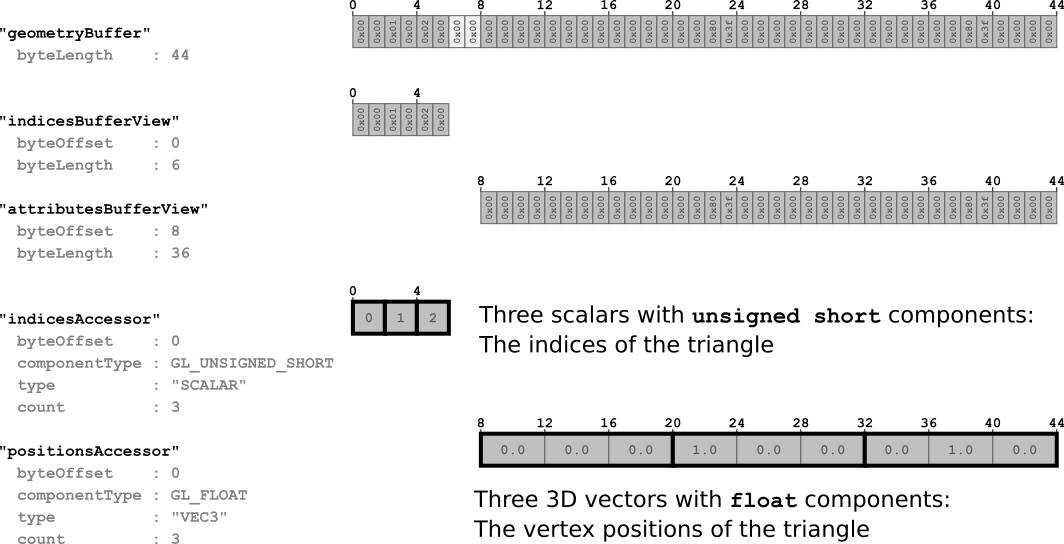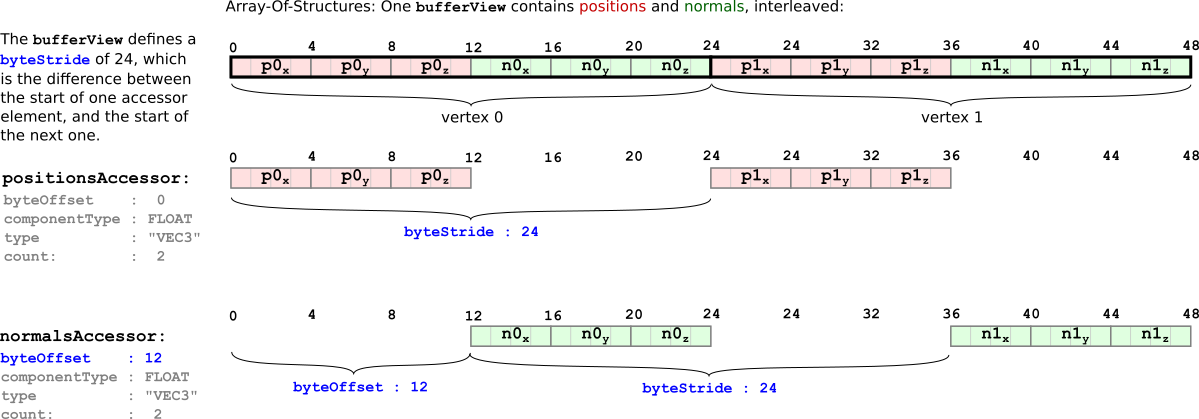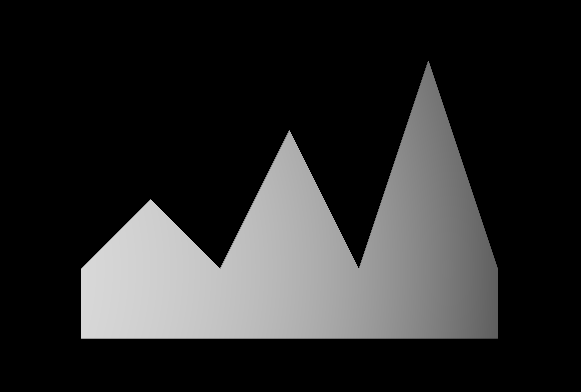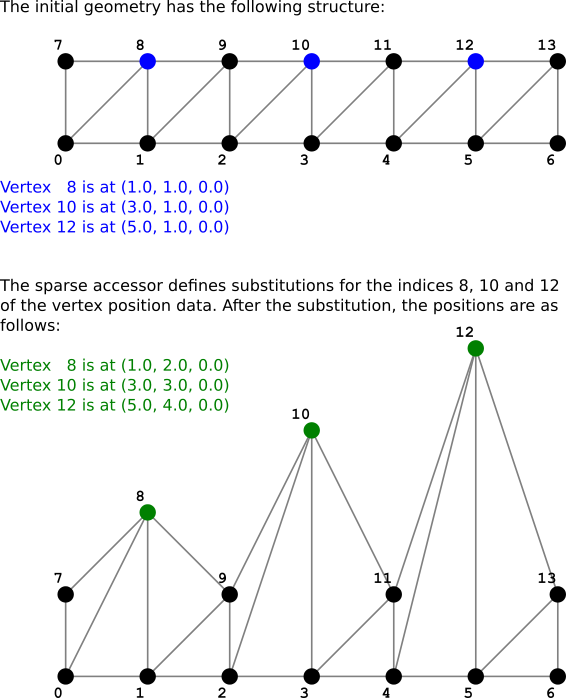glTF-Tutorials
| Previous: Scenes and Nodes | Table of Contents | Next: Simple Animation |
Buffers, BufferViews, and Accessors
An example of buffer, bufferView, and accessor objects was already given in the Minimal glTF File section. This section will explain these concepts in more detail.
Buffers
A buffer represents a block of raw binary data, without an inherent structure or meaning. This data is referred to by a buffer using its uri. This URI may either point to an external file, or be a data URI that encodes the binary data directly in the JSON file. The minimal glTF file contained an example of a buffer, with 44 bytes of data, encoded in a data URI:
"buffers" : [
{
"uri" : "data:application/octet-stream;base64,AAABAAIAAAAAAAAAAAAAAAAAAAAAAIA/AAAAAAAAAAAAAAAAAACAPwAAAAA=",
"byteLength" : 44
}
],

Image 5a: The buffer data, consisting of 44 bytes.
Parts of the data of a buffer may have to be passed to the renderer as vertex attributes, or as indices, or the data may contain skinning information or animation key frames. In order to be able to use this data, additional information about the structure and type of this data is required.
BufferViews
The first step of structuring the data from a buffer is with bufferView objects. A bufferView represents a “slice” of the data of one buffer. This slice is defined using an offset and a length, in bytes. The minimal glTF file defined two bufferView objects:
"bufferViews" : [
{
"buffer" : 0,
"byteOffset" : 0,
"byteLength" : 6,
"target" : 34963
},
{
"buffer" : 0,
"byteOffset" : 8,
"byteLength" : 36,
"target" : 34962
}
],
The first bufferView refers to the first 6 bytes of the buffer data. The second one refers to 36 bytes of the buffer, with an offset of 8 bytes, as shown in this image:

Image 5b: The buffer views, referring to parts of the buffer.
The bytes that are shown in light gray are padding bytes that are required for properly aligning the accessors, as described below.
Each bufferView additionally contains a target property. This property may later be used by the renderer to classify the type or nature of the data that the buffer view refers to. The target can be a constant indicating that the data is used for vertex attributes (34962, standing for ARRAY_BUFFER), or that the data is used for vertex indices (34963, standing for ELEMENT_ARRAY_BUFFER).
At this point, the buffer data has been divided into multiple parts, and each part is described by one bufferView. But in order to really use this data in a renderer, additional information about the type and layout of the data is required.
Accessors
An accessor object refers to a bufferView and contains properties that define the type and layout of the data of this bufferView.
Data type
The type of an accessor’s data is encoded in the type and the componentType properties. The value of the type property is a string that specifies whether the data elements are scalars, vectors, or matrices. For example, the value may be "SCALAR" for scalar values, "VEC3" for 3D vectors, or "MAT4" for 4×4 matrices.
The componentType specifies the type of the components of these data elements. This is a GL constant that may, for example, be 5126 (FLOAT) or 5123 (UNSIGNED_SHORT), to indicate that the elements have float or unsigned short components, respectively.
Different combinations of these properties may be used to describe arbitrary data types. For example, the minimal glTF file contained two accessors:
"accessors" : [
{
"bufferView" : 0,
"byteOffset" : 0,
"componentType" : 5123,
"count" : 3,
"type" : "SCALAR",
"max" : [ 2 ],
"min" : [ 0 ]
},
{
"bufferView" : 1,
"byteOffset" : 0,
"componentType" : 5126,
"count" : 3,
"type" : "VEC3",
"max" : [ 1.0, 1.0, 0.0 ],
"min" : [ 0.0, 0.0, 0.0 ]
}
],
The first accessor refers to the bufferView with index 0, which defines the part of the buffer data that contains the indices. Its type is "SCALAR", and its componentType is 5123 (UNSIGNED_SHORT). This means that the indices are stored as scalar unsigned short values.
The second accessor refers to the bufferView with index 1, which defines the part of the buffer data that contains the vertex attributes - particularly, the vertex positions. Its type is "VEC3", and its componentType is 5126 (FLOAT). So this accessor describes 3D vectors with floating point components.
Data layout
Additional properties of an accessor further specify the layout of the data. The count property of an accessor indicates how many data elements it consists of. In the example above, the count has been 3 for both accessors, standing for the three indices and the three vertices of the triangle, respectively. Each accessor also has a byteOffset property. For the example above, it has been 0 for both accessors, because there was only one accessor for each bufferView. But when multiple accessors refer to the same bufferView, then the byteOffset describes where the data of the accessor starts, relative to the bufferView that it refers to.
Data alignment
The data that is referred to by an accessor may be sent to the graphics card for rendering, or be used at the host side as animation or skinning data. Therefore, the data of an accessor has to be aligned based on the type of the data. For example, when the componentType of an accessor is 5126 (FLOAT), then the data must be aligned at 4-byte boundaries, because a single float value consists of four bytes. This alignment requirement of an accessor refers to its bufferView and the underlying buffer. Particularly, the alignment requirements are as follows:
- The
byteOffsetof anaccessormust be divisible by the size of itscomponentType. - The sum of the
byteOffsetof an accessor and thebyteOffsetof thebufferViewthat it refers to must be divisible by the size of itscomponentType.
In the example above, the byteOffset of the bufferView with index 1 (which refers to the vertex attributes) was chosen to be 8, in order to align the data of the accessor for the vertex positions to 4-byte boundaries. The bytes 6 and 7 of the buffer are thus padding bytes that do not carry relevant data.
Image 5c illustrates how the raw data of a buffer is structured using bufferView objects and is augmented with data type information using accessor objects.

Image 5c: The accessors defining how to interpret the data of the buffer views.
Data interleaving
The data of the attributes that are stored in a single bufferView may be stored as an Array-Of-Structures. A single bufferView may, for example, contain the data for vertex positions and for vertex normals in an interleaved fashion. In this case, the byteOffset of an accessor defines the start of the first relevant data element for the respective attribute, and the bufferView defines an additional byteStride property. This is the number of bytes between the start of one element of its accessors, and the start of the next one. An example of how interleaved position and normal attributes are stored inside a bufferView is shown in Image 5d.

Image 5d: Interleaved accessors in one buffer view.
Data contents
An accessor also contains min and max properties that summarize the contents of their data. They are the component-wise minimum and maximum values of all data elements contained in the accessor. In the case of vertex positions, the min and max properties thus define the bounding box of an object. This can be useful for prioritizing downloads, or for visibility detection. In general, this information is also useful for storing and processing quantized data that is dequantized at runtime, by the renderer, but details of this quantization are beyond the scope of this tutorial.
Sparse accessors
With version 2.0, the concept of sparse accessors was introduced in glTF. This is a special representation of data that allows very compact storage of multiple data blocks that have only a few different entries. For example, when there is geometry data that contains vertex positions, this geometry data may be used for multiple objects. This may be achieved by referring to the same accessor from both objects. If the vertex positions for both objects are mostly the same and differ for only a few vertices, then it is not necessary to store the whole geometry data twice. Instead, it is possible to store the data only once, and use a sparse accessor to store only the vertex positions that differ for the second object.
The following is a complete glTF asset, in embedded representation, that shows an example of sparse accessors:
{
"scenes" : [ {
"nodes" : [ 0 ]
} ],
"nodes" : [ {
"mesh" : 0
} ],
"meshes" : [ {
"primitives" : [ {
"attributes" : {
"POSITION" : 1
},
"indices" : 0
} ]
} ],
"buffers" : [ {
"uri" : "data:application/gltf-buffer;base64,AAAIAAcAAAABAAgAAQAJAAgAAQACAAkAAgAKAAkAAgADAAoAAwALAAoAAwAEAAsABAAMAAsABAAFAAwABQANAAwABQAGAA0AAAAAAAAAAAAAAAAAAACAPwAAAAAAAAAAAAAAQAAAAAAAAAAAAABAQAAAAAAAAAAAAACAQAAAAAAAAAAAAACgQAAAAAAAAAAAAADAQAAAAAAAAAAAAAAAAAAAgD8AAAAAAACAPwAAgD8AAAAAAAAAQAAAgD8AAAAAAABAQAAAgD8AAAAAAACAQAAAgD8AAAAAAACgQAAAgD8AAAAAAADAQAAAgD8AAAAACAAKAAwAAAAAAIA/AAAAQAAAAAAAAEBAAABAQAAAAAAAAKBAAACAQAAAAAA=",
"byteLength" : 284
} ],
"bufferViews" : [ {
"buffer" : 0,
"byteOffset" : 0,
"byteLength" : 72,
"target" : 34963
}, {
"buffer" : 0,
"byteOffset" : 72,
"byteLength" : 168
}, {
"buffer" : 0,
"byteOffset" : 240,
"byteLength" : 6
}, {
"buffer" : 0,
"byteOffset" : 248,
"byteLength" : 36
} ],
"accessors" : [ {
"bufferView" : 0,
"byteOffset" : 0,
"componentType" : 5123,
"count" : 36,
"type" : "SCALAR",
"max" : [ 13 ],
"min" : [ 0 ]
}, {
"bufferView" : 1,
"byteOffset" : 0,
"componentType" : 5126,
"count" : 14,
"type" : "VEC3",
"max" : [ 6.0, 4.0, 0.0 ],
"min" : [ 0.0, 0.0, 0.0 ],
"sparse" : {
"count" : 3,
"indices" : {
"bufferView" : 2,
"byteOffset" : 0,
"componentType" : 5123
},
"values" : {
"bufferView" : 3,
"byteOffset" : 0
}
}
} ],
"asset" : {
"version" : "2.0"
}
}
The result of rendering this asset is shown in Image 5e:

Image 5e: The result of rendering the simple sparse accessor asset.
The example contains two accessors: one for the indices of the mesh, and one for the vertex positions. The one that refers to the vertex positions defines an additional accessor.sparse property, which contains the information about the sparse data substitution that should be applied:
"accessors" : [
...
{
"bufferView" : 1,
"byteOffset" : 0,
"componentType" : 5126,
"count" : 14,
"type" : "VEC3",
"max" : [ 6.0, 4.0, 0.0 ],
"min" : [ 0.0, 0.0, 0.0 ],
"sparse" : {
"count" : 3,
"indices" : {
"bufferView" : 2,
"byteOffset" : 0,
"componentType" : 5123
},
"values" : {
"bufferView" : 3,
"byteOffset" : 0
}
}
} ],
This sparse object itself defines the count of elements that will be affected by the substitution. The sparse.indices property refers to a bufferView that contains the indices of the elements which will be replaced. The sparse.values refers to a bufferView that contains the actual data.
In the example, the original geometry data is stored in the bufferView with index 1. It describes a rectangular array of vertices. The sparse.indices refer to the bufferView with index 2, which contains the indices [8, 10, 12]. The sparse.values refers to the bufferView with index 3, which contains new vertex positions, namely, [(1,2,0), (3,3,0), (5,4,0)]. The effect of applying the corresponding substitution is shown in Image 5f.

Image 5f: The substitution that is done with the sparse accessor.
| Previous: Scenes and Nodes | Table of Contents | Next: Simple Animation |